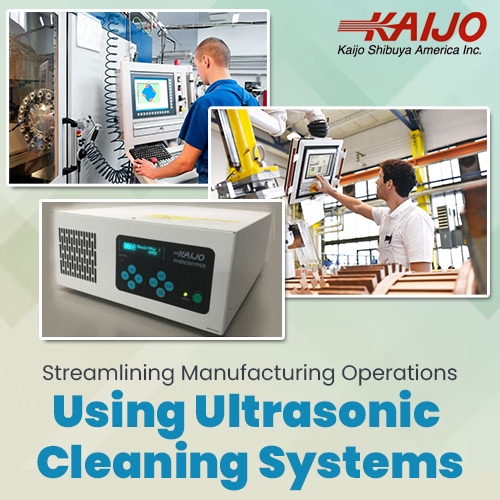Streamlining Manufacturing Operations Using Ultrasonic Cleaning Systems
November 14, 2023
 When cleaning is a part of the manufacturing process, efficient cleaning can streamline operations. Traditional cleaning methods, such as soaking in chemicals, manual scrubbing, and pressure washing, are expensive, time-consuming, and often give inconsistent results. Ultrasonic cleaning works with plain water and cleans completely every time. The technology relies on a mechanical process that acts quickly to remove all traces of contamination from the surfaces to be cleaned. Switching to ultrasonic cleaning systems is an attractive solution for manufacturers looking for ways to reduce costs and increase the efficiency of manufacturing operations.
When cleaning is a part of the manufacturing process, efficient cleaning can streamline operations. Traditional cleaning methods, such as soaking in chemicals, manual scrubbing, and pressure washing, are expensive, time-consuming, and often give inconsistent results. Ultrasonic cleaning works with plain water and cleans completely every time. The technology relies on a mechanical process that acts quickly to remove all traces of contamination from the surfaces to be cleaned. Switching to ultrasonic cleaning systems is an attractive solution for manufacturers looking for ways to reduce costs and increase the efficiency of manufacturing operations.
The Science Behind Ultrasonic Cleaning
When parts of a liquid are subjected to very low pressure, cavitation bubbles form in the liquid. Ultrasonic cleaning takes advantage of this effect. After an ultrasonic generator produces a high-frequency signal, a transducer immersed in the cleaning solution converts the signal to sound waves. The sound waves, ranging from 20 kHz to the MHz range, travel throughout the cleaning tank, creating pressure peaks and troughs.
The sound wave troughs have a low enough pressure for microscopic cavitation bubbles to form. As the wave travels, the bubbles burst in the subsequent pressure peaks. When the bubbles burst, they release a tiny but powerful jet of cleaning solution that dislodges contaminants from adjacent surfaces. The bubbles form and burst in time with the ultrasonic frequency. Part surfaces are usually completely clean after 10 to 15 minutes of this high-frequency jet-powered action. Ultrasonic cleaning systems can be set up for precisely the proper cleaning performance. Once set up, the systems will deliver consistent results every time.
Ultrasonic Cleaning Systems Increase Efficiency While Reducing Waste and Costs
Because ultrasonic cleaning relies on the jet action produced by cavitation bubbles, it does not require the use of expensive chemicals. Instead, ultrasonic cleaners work quickly and clean consistently to speed up manufacturing operations and improve output quality.
With traditional cleaning methods, it’s hard to set firm timelines. Employees have to soak, scrub, or wash until they can’t see any more dirt. If they have a fixed time for cleaning, some parts may not be cleaned thoroughly to meet requirements. Streamlining manufacturing operations that require such cleaning can be challenging.
Ultrasonic systems can clean in less time than traditional cleaning methods, and the timing is consistent. Planning becomes easier. The cost of chemicals and chemical handling is eliminated, as is chemical waste. The higher efficiency combined with lower costs and less waste can result in better streamlining of manufacturing operations and substantially improve overall facility performance.
Ultrasonic Technology Is Clean and Sustainable for Easy Regulatory Compliance
Because ultrasonic cleaning does not use dangerous chemicals, it is not subject to regulations requiring waste neutralization, leak detection, spill handling procedures, and safe storage. The process is environmentally friendly and completely safe. Operators can place the parts to be cleaned in the bath, switch on the cleaning system with a timer, and come back later to remove completely clean parts. The safety issues coming from employees cleaning with sharp and pointy tools don’t exist. Workplace safety increases and the manufacturing process footprint is smaller.
Switching to Ultrasonic Cleaning Can Be Easy with an Experienced Supplier
An experienced manufacturer of ultrasonic cleaning systems can help customers switch with minimal disruption. Ultrasonic cleaning can integrate seamlessly with existing manufacturing setups. Often, existing cleaning tanks can be reused. Staff training to keep the systems working optimally is essential.
After evaluating the manufacturing process, an experienced supplier can determine where ultrasonic cleaning would be most effective. Specific benefits, ROI, and the effects on various aspects of the operations can be identified. The interests of plant managers, process engineers, and quality assurance teams can be considered. Special requirements such as tank heating or the use of mild solvents can be explored. Customization to reflect unique features is often necessary. When such a process is complete, the switch to ultrasonic cleaning can occur in a planned, scheduled way.
Kaijo Can Help Customers Make the Switch
As one of the leading ultrasonic cleaner manufacturers, Kaijo has the experience and in-house expertise to help customers seamlessly switch to ultrasonic cleaning. Kaijo’s innovative technology and complete line of ultrasonic cleaning equipment make it the ideal partner. In addition, Kaijo provides expert guidance to ensure customers use the right equipment and the latest technology to meet their cleaning requirements.





